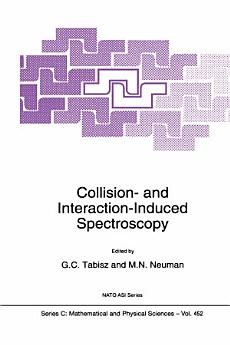Collision- and Interaction-Induced Spectroscopy
G.C. Tabisz · Murray N. Neuman
dec. de 2012 · Nato Science Series C Libro 452 · Springer Science & Business Media
Libro electrónico
588
Páxinas
reportAs valoracións e as recensións non están verificadas Máis información
Acerca deste libro electrónico
Collision-or interaction-induced spectroscopy refers to radiative transitions, which are forbidden in free atoms or molecules, but which occur in clusters of interacting atoms or molecules. The most common phenomena are induced absorption, in the infrared region, and induced light scattering, which involves inelastic scattering of visible laser light. The particle interactions giving rise to the necessary induced dipole moments and polarizabilities are modelled at long range by multipole expansions; at short range, electron overlap and exchange mechanisms come into play. Information on atomic and molecular interactions and dynamics in dense media on a picosecond timescale may be drawn from the spectra. Collision-induced absorption in the infrared was discovered at the University of Toronto in 1949 by Crawford, Welsh and Locke who studied liquid O and N. Through the 1950s and 1960s, 2 2 experimental elucidation of the phenomenon, particularly in gases, continued and theoretical underpinnings were established. In the late 1960s, the related phenomenon of collision-induced light scattering was first observed in compressed inert gases. In 1978, an 'Enrico Fermi' Summer School was held at Varenna, Italy, under the directorship of J. Van Kranendonk. The lectures, there, reviewed activity from the previous two decades, during which the approach to the subject had not changed greatly. In 1983, a highly successful NATO Advanced Research Workshop was held at Bonas, France, under the directorship of G. Birnbaum. An important outcome of that meeting was the demonstration of the maturity and sophistication of current experimental and theoretical techniques.
Valora este libro electrónico
Dános a túa opinión.
Información de lectura
Smartphones e tabletas
Instala a aplicación Google Play Libros para Android e iPad/iPhone. Sincronízase automaticamente coa túa conta e permíteche ler contido en liña ou sen conexión desde calquera lugar.
Portátiles e ordenadores de escritorio
Podes escoitar os audiolibros comprados en Google Play a través do navegador web do ordenador.
Lectores de libros electrónicos e outros dispositivos
Para ler contido en dispositivos de tinta electrónica, como os lectores de libros electrónicos Kobo, é necesario descargar un ficheiro e transferilo ao dispositivo. Sigue as instrucións detalladas do Centro de Axuda para transferir ficheiros a lectores electrónicos admitidos.







